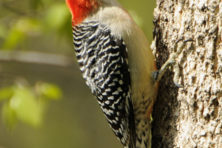Door To Nature: Patience at the Bird Feeders
- Share
- Tweet
- Pin
- Share

This past month, I’ve often looked out at the feeders in my front yard and noticed no birds. Few of the typical seed-eaters have been here, and many seeds that I put out at dusk are still on the platforms well after dawn.
Then, all of a sudden, the birds arrive and begin chowing down. When the flock of blue jays flies in, they dominate the platform feeders and scare off all the smaller birds.
I place shelled peanut halves on the platform’s lower level specifically for the chickadees and nuthatches, but the jay finds them and grabs as many as it can carry in its beak.
A good friend gave me some peanuts in the shell and placed a few handfuls on top of the bigger platform. At first, the jays didn’t seem to know what they were, but eventually, they realized there was tasty food inside. They can usually carry only one at a time, which keeps them busy hacking open each shell to get the nut.
It seems blue jays will eat anything placed on the feeders. Years ago, when Roy and I lived in the Ridges Rangelight residence, I liked to make sourdough pancakes. When I had fried all the batter, there were occasionally leftover pancakes. I would tear them into small chunks and put them on the feeder platform. The jays fought over them and crammed as many as possible into their beaks.
I realized that one reason there are no birds at the feeders is because my resident sharp-shinned hawk is lurking in the nearby woods, patiently waiting for the first unwary bird to fly into the feeders. I once saw it chase and catch a male red-bellied woodpecker and land on the driveway on top of its prey.
The sharp-shinned hawk is an accipiter, or part of a genus of medium-sized forest-dwelling hawks. Like Cooper’s hawks, they pluck the feathers before consuming the bird. Last week I went to Sturgeon Bay and when I returned, I saw many small gray feathers scattered by the wind on the snow. I knew the sharpie had caught a dark-eyed junco.
Blue jays are considered the alarm bells of the forest. They call loudly when there is danger, so when they do come to the feeders, the other birds may feel it is safe for them to do the same.
Last week, it was 30 minutes after sunrise before any bird came here. One blue jay flew in from the southeast, but soon headed back in the same direction as the sharpie flew in from the northwest.
Then the hawk sat in the cedar trees behind the feeders looking towards the ground for a hidden junco. I went out on the deck to chase it away, but it only flew to a higher branch in the nearby maple tree. This bird is so used to being here that it isn’t even afraid of me anymore.
I went back inside and timed the hawk. It sat on the maple branch for five minutes before leaving the area. Then I noticed a hairy woodpecker clinging to the trunk of a small ash tree behind the feeders. It stayed motionless for 44 minutes after the hawk disappeared. These small birds seem to know that sitting motionless is key to their survival until other birds fly into the yard, signaling it is safe to move.
Blue jays and mourning doves are easy targets for accipiters; they are slow flyers and make a hearty meal for these woodland hawks. That’s why, when the blue jays return to the feeders, it usually means the coast is clear, and the smaller birds and woodpeckers come back to eat.
As the snow cover diminishes on the open fields, start looking for returning horned larks. These sparrow-sized birds nest in many of the inland meadows away from the lakeshore. When snow remains in the fields, you can see them searching for weed seeds along the shoulders of roads. They will fly up into the field as you approach, letting you see their dark tail.
Patience is vital for birds at the feeders, whether they be accipiters or small songbirds. As birdwatchers, we need to be patient too.


